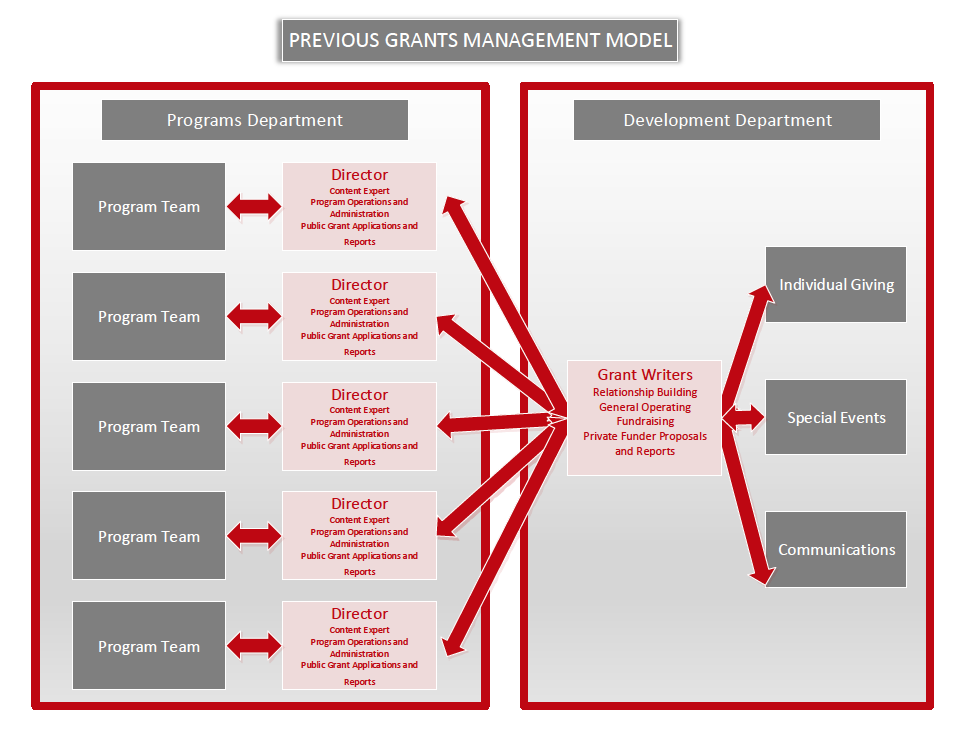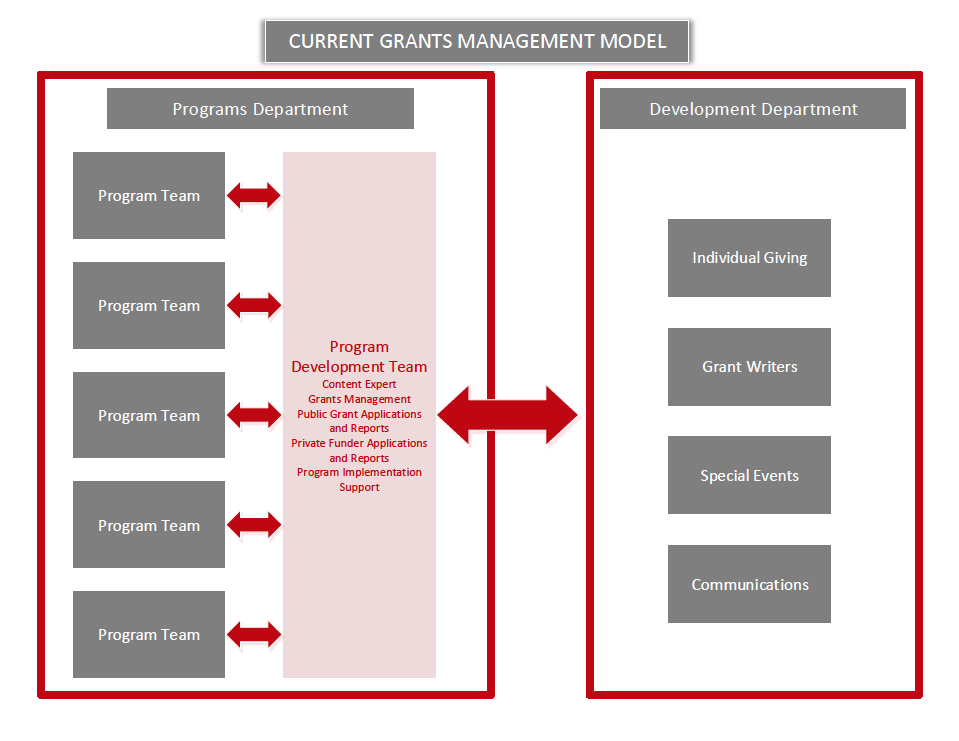Summary
Most non-profits assign grants management activities, including application development/submission and reporting, for private and public funding sources to fund development (or fundraising) departments. The AIDS Foundation of Chicago (AFC) operates an innovative alternative model to grants management. AFC’s Program Development (PD) team includes grants management personnel with programmatic content expertise. The PD department is located within the programs division of the agency and each member is assigned a program portfolio for which they perform grants management activities. In addition, team members are embedded within each programmatic team which means that PD staff attend program team operating, project implementation, budget expenditure review, evaluation, and community partner meetings. Overall, this innovative and unique structural change to embed grants management staff within the programs department has resulted in a more efficient use of programmatic and fundraising staff resources to identify and secure private and public funding for the agency.
Article
Most nonprofits assign grants management activities, including application development/submission and reporting, for private (and sometimes public) funding sources to development (or fundraising) departments. The individuals implementing the organization’s programs and who are experts in the programmatic activities performed and outcomes achieved are located in other departments. This creates a separation between those doing the work and those writing about the work. More than five years ago, the AIDS Foundation of Chicago (AFC) changed its model away from this standard and, in doing so, increased its fund development efficiency and strengthened program operations.
Prior to July 2012, AFC operated on the more standard model of fundraising for programs: A grant writer in the development department identified private funding opportunities, wrote and submitted applications, and completed reporting requirements. Programs staff were responsible for these same duties for public funding opportunities.
There were multiple challenges to this model. At AFC, it meant that the limited staff in the development department needed to understand programmatic operations and best practices for all of AFC’s 10 programmatic areas. This was extremely difficult given the prospect research, relationship-building with funders, and general operating fundraising activities that the development department staff also completed. In order to submit competitive applications for local and national public funding, program staff -- in addition to their program operations and administrative expertise -- needed to possess skills in new program development; literature review; proposal writing, budget development; work plan and logic model formation; government forms; and multiple application portals.

AFC’s Previous Grant Management Model
This structure was neither realistic nor efficient. The result was that private grants were not always written in ways that accurately described the program. This created confusion and led to difficulties responding to funder follow-up questions during site visits as clarifying information from program staff occasionally did not align with what was written in the submitted narrative. It also created challenges during the reporting period when actual programmatic activities performed did not correspond precisely to what was described in the original proposal. Program staff were limited in the number of government grants that they could submit. Program administration is a constant activity. Therefore, it was extremely difficult for program staff to dedicate hours during the work day to managing an application process and writing narrative in addition to their program management responsibilities. In addition, not all program staff had the research, writing, and grant application skills to manage the process. In July 2012, AFC changed that structure by forming the Program Development (PD) team.
AFC’s newly formed PD team joined the programs division of the agency. The team recruited grants management personnel with programmatic content expertise; all staff members are also required to have strong writing and editing skills. Since 2012, PD has grown from three staff members to five, with members possessing expertise in a variety of areas including: HIV/AIDS education, prevention, treatment and supportive services; homelessness prevention, street outreach and permanent supportive housing; the criminal justice system; public health policy and advocacy; and community development and coalition building. Each member is assigned a program portfolio for which they perform grants management activities, including the development and submission of all new and renewal public and private grant applications and required reports.
Beyond applications and reports, PD staff members are embedded within each programmatic team. This means that PD staff attend program team operating, project implementation, evaluation, and community partner meetings. In addition, they organize and facilitate budget expenditure review meetings. PD staff members have an educational and experiential background in the programmatic content area they support and attend professional development opportunities to maintain their knowledge base regarding emerging trends and best practices. Given their positions, they are also able to complete stand-alone tasks to support the programmatic teams they support, such as researching funding regulations. PD staff act as programmatic liaisons to the Development Department to support those staff members in their continued activities related to prospect researching, relationship-building, and general operating fundraising.

AFC’s Current Grant Management Structure
The result of this change is a streamlined process for funding acquisition. The grant application process is faster, as the PD member has content area expertise, is familiar with various government application portals, has experience with required forms and grant writing, and has an array of previous applications as well as a team of other PD members available for reference. As this is her specific responsibility, the PD staff member has the time to dedicate to both writing the narrative and managing the process. The average amount of time to write the narrative for a public grant is 80-100 hours, which includes program design meetings, research regarding population need and best practices, and time spent writing. In addition, a PD staff member will need at least an additional 40 hours to manage the overall application process, including planning and design meetings, partnership development, budget and budget narrative, attachments, required forms, and online submission. That is more than three weeks of work time that a Program Director does not need to allocate away from program management.
The reporting process is also improved; the PD member can complete 90-95 percent of the report independently due to active participation in programmatic meetings. The direct and ongoing line of contact between program staff and PD staff improved both application and reporting processes. Since PD formation in 2012, the number of applications and reports submitted annually has grown from 87 to 154, a 77 percent increase.
Additional benefits of this structure include the presence of a person at the programmatic table who can assist project staff with information related to budgets, contractual scopes, and quality assurance. This allows program staff to remain focused on service delivery during application and report submission, rather than dividing their time between very different activities.
Due to the specific programmatic nature of the PD position, staff members are eligible staff for public contracts within administrative line items. This allows general operating funds, which support development and other staff, to be reallocated for unfunded agency needs. At AFC, general operating monies are used to support its policy and advocacy department and community mobilizing activities which are generally not allowable activities within public grants.
Overall, this structural change to embed grants management staff within the programs department has resulted in a more efficient use of programmatic and fundraising staff resources to identify and secure private and public funding for the agency.
Author Bio
Andrea Dakin, PhD, MA is currently the Senior Director of Program Development of the AIDS Foundation of Chicago. She leads the Program Development department, which designs new programs and initiatives in response to community need and available funding opportunities. She has more than 20 years of experience designing, implementing, and evaluating social service programs. Her background includes work in HIV/AIDS services, homeless and housing programs for singles and families, domestic violence, and program development.


